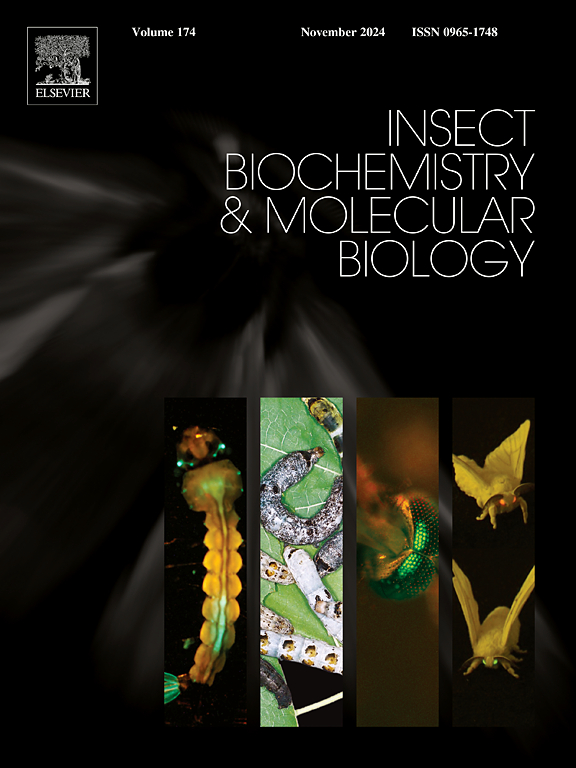Seminal fluid proteins in the Queensland fruit fly: Tissue origins, effects of mating and comparative genomics
IF 3.2
2区 农林科学
Q2 BIOCHEMISTRY & MOLECULAR BIOLOGY
引用次数: 0
Abstract
In many insect species, the ability of males to inhibit their mates from remating is an important component of fitness. This ability is also essential for the effective management of insect pests, including tephritid fruit flies, using the Sterile Insect Technique. Here we apply transcriptomics and proteomics to male reproductive tissues before and after mating to characterize components of semen that might mediate remating inhibition in Queensland fruit fly. We found 144 genes whose transcripts were enriched, or proteins expressed, in reproductive tissue and which also varied in amount after mating. Some were associated with testes, accessory glands and ejaculatory apodeme, but those from the ejaculatory apodeme were over-represented compared to those not enriched in reproductive tissue or mating responsive. These included 13 related genes clustered within one Mb on chromosome 5. Functional annotations implicated a broad range of biochemical processes in the genes/proteins enriched in reproductive tissue and mating responsive, with cuticle structure most commonly implicated among the subset of these that were apodeme-enriched and a kinase involved in vitellogenesis implicated for one of the 13 clustered genes. We did not find a homolog of the much studied Drosophila melanogaster Sex Peptide but comparative genomics indicated that some of the tissue-enriched, mating responsive genes/proteins were rapidly evolving in tephritids (including in the Queensland fruit fly lineage), suggesting recent adaptation to new functional niches. Our results provide a set of candidate mediators of remating inhibition for further functional testing.

昆士兰果蝇的精液蛋白:组织起源,交配的影响和比较基因组学。
在许多昆虫物种中,雄性抑制其配偶留下的能力是健康的重要组成部分。这种能力对于利用昆虫不育技术有效管理包括伤寒果蝇在内的害虫也是必不可少的。在这里,我们应用转录组学和蛋白质组学对交配前后的雄性生殖组织进行了研究,以表征可能介导昆士兰果蝇生殖抑制的精液成分。我们发现144个基因的转录本在生殖组织中富集或表达,并且在交配后数量也有所不同。有些与睾丸、附属腺体和射精腺有关,但与生殖组织或交配反应不丰富的细胞相比,射精腺的细胞比例过高。其中13个相关基因聚集在5号染色体1 Mb内。功能注释涉及生殖组织中丰富的基因/蛋白质的广泛生化过程和交配反应,其中角质层结构最常涉及apodee富集的这些子集,参与卵黄形成的激酶涉及13个聚集基因中的一个。我们没有发现与黑腹果蝇性肽同源的基因,但比较基因组学表明,一些富含组织的交配反应基因/蛋白正在迅速进化,这表明它们最近适应了新的功能生态位。我们的结果为进一步的功能测试提供了一组残留抑制的候选介质。
本文章由计算机程序翻译,如有差异,请以英文原文为准。
求助全文
约1分钟内获得全文
求助全文
来源期刊
CiteScore
7.40
自引率
5.30%
发文量
105
审稿时长
40 days
期刊介绍:
This international journal publishes original contributions and mini-reviews in the fields of insect biochemistry and insect molecular biology. Main areas of interest are neurochemistry, hormone and pheromone biochemistry, enzymes and metabolism, hormone action and gene regulation, gene characterization and structure, pharmacology, immunology and cell and tissue culture. Papers on the biochemistry and molecular biology of other groups of arthropods are published if of general interest to the readership. Technique papers will be considered for publication if they significantly advance the field of insect biochemistry and molecular biology in the opinion of the Editors and Editorial Board.

 求助内容:
求助内容: 应助结果提醒方式:
应助结果提醒方式:


